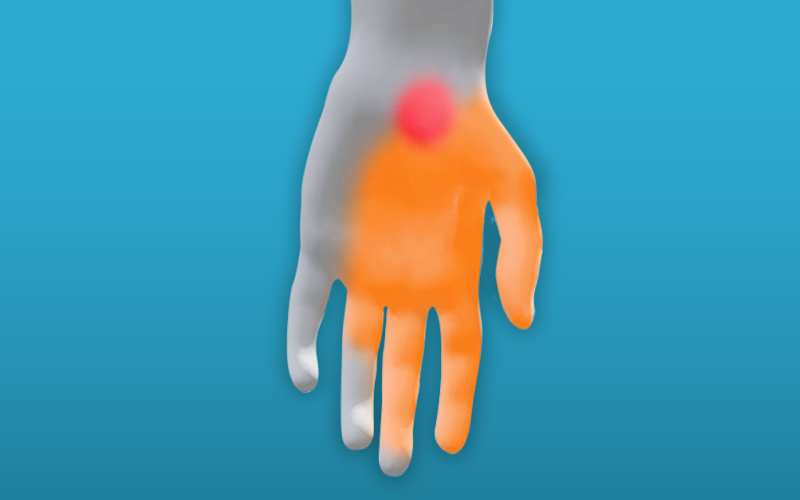
Carpal Tunnel Syndrome (CTS)
What is it?
The carpal tunnel is a canal formed between the small bones of the wrist (carpal bones) and a ligament that lies across the front of the wrist. The median nerve is one of the structures that pass through this canal.
In Carpal Tunnel Syndrome (CTS) the median nerve becomes compressed within the canal.
What are the common symptoms?
Symptoms include pins and needles, pain, aching and/or numbness commonly in the thumb, index, middle and half the ring finger, but you may feel that the whole hand is affected. You may feel weakness of the hand which can cause poor grip, leading you to drop objects. Your skin may feel more dry than usual.
In most cases, there isn’t an obvious cause for CTS. It is more common in manual workers, especially with jobs involving a lot of wrist movement, so overuse of the hand may be a factor.
The following are all associated with CTS: pregnancy, obesity, an underactive thyroid, diabetes, any arthritis affecting the wrist and the menopause.
How to manage Carpal Tunnel Syndrome
Night-time pain can be relieved by gently shaking your hand and wrist or hanging your hand over the side of the bed.
You may benefit from wearing wrist splint during the night. You can purchase a splint from a number of places online. The aim of the splint is keep the wrist straight. See the instructions at the end of this section to learn how to bend the bar to ensure your wrist is flat, i.e. not bent back or downwards. Remove it in the day unless you are doing aggravating activities e.g.: holding a phone.
Watch out for red marks on your skin due to rubbing or pressure points or a rash due to heat or allergy to the material.
Elastic or Neoprene splints may be hand-washed or machine-washed in an ‘easy care’ load (40°). Make sure the Velcro straps are fastened before putting the splint in a washing machine or place it in a pillow case.
Exercises
There is some evidence to suggest exercising the nerve can help the oxygen and blood flow. Repeat this sequence x5 a few times a day.


If you have been provided with a neoprene wrist splint or have purchased a splint, follow these fitting guidelines:
- Undo the velcro straps and place the open splint on a table. Place your hand palm down against the splint with the big knuckles of the fingers just over the edge of the splint material.
- Do the 3 straps up over the back of the wrist/ forearm.
- The strap closest to the fingers goes through the thumb web and fastens on the back of the hand.
How to bend the bar in the splint to fit:
When you receive the splint, the bar is bent to position the wrist to bend approx. 45 degrees backwards splint.

Remove the bar from the pocket and create a new bend at the wrist level in the opposite direction to the one already there. Your wrist should be straight but the end of the bar will still be bent.
Slide the bar back into the pocket at the wrist end of the splint; you can remove the splint to do this.

It should look like this when on correctly.

NB: Ensure the splint is not too tight as you will be wearing it overnight
How to prevent Carpal Tunnel Syndrome and manage flare ups?
Avoid sleeping with your hands held bent or curled downwards – this compresses the front of the wrist and can irritate the median nerve, causing pins and needles into your hand.
Try to avoid over gripping or typing too forcefully. This may cause swelling around the tendons that also pass through the tunnel, and so irritate the median nerve.
Taking regular breaks at work if you are using your hands repetitively will help, especially if you introduce gentle movement exercises of the wrist and fingers such as:
Stretch your hands, fingers, and wrists often. Rotate wrists in circles and flex and extend your hand and fingers.
Don’t smoke – this will affect the circulation in your hands and feet and may make CTS symptoms worse.
